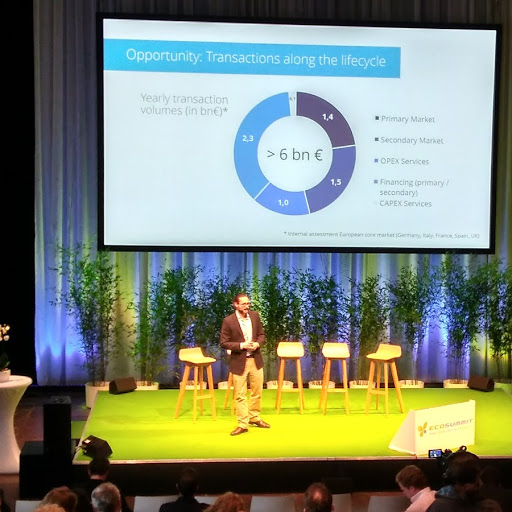Ecosummit Berlin was the 9th iteration of the start-up event and it was held under sunny skies by the riverside. An international potpourri of start-ups, utilities and venture capitals gathered for the two-day event, to get a whiff of what the clean-tech industry has to offer in the years to come.
A hot topic for the renewable energy economy now are software solutions that help integrate and manage assets, energy flows and improve customer experiences. A survey published by GTM asked 600 solar developers to identify the current challenges they face. Many of whom responded, that bespoke technological solutions for specific problems are what they are looking for.
In the storage and grid service realm British-based battery management system provider Moixa has gained some attention from battery manufacturers and Japanese utility Tepco. The startup has been running its business in the UK since 2004 and is looking forward to expanding to Japan. By providing small capacity (2-3 kWh) home batteries, equipped with the start-ups own smart management software,
Moixa’s approach to storage differs from those companies that strive increasingly larger capacities. Consumption and production can be distributed among a whole network of batteries, to offset isolated events in which battery capacities are insufficient.
“This makes actually more sense than installing a bigger battery that exceeds standard household capacity by a greater margin” says Simon Daniel, CEO at Moixa. “Especially for markets like the UK and Japan smaller batteries make more sense, as homes are usually smaller and thus customers are less willing to use precious space for a physically larger battery”.
Moixa recently signed a deal with the Japanese battery producer Itochu and the utility Tepco, to penetrate the looming Japanese residential PV market. Stressing its experience with rather isolated grid-architectures from the UK, Moixa argued that it is an ideal provider of the service for Japan which has a similarly isolated grid architecture.
Dutch Eneco Smart Energy is another utility showing greater interest in software solutions to the challenges prompted by distributed energy resources. Through close cooperation with start-up's it is possible to keep atop of developments in a rapidly changing energy economy. Since 2007 the utility seeks to maintain a purely renewable energy profile. Following some successful years in the Netherlands, Eneco expanded its customer base to Belgium and Germany.
The Dutch company emphasised the changing roles of utilities in a changing energy market. “Due to the spread of distributed renewable energy we see that the value chain is changing for everybody,” states Leonie Baneke, Investment Director at Eneco Smart Energy. “What makes it hard for utilities, is that the market is just changing and the new place for utilities has not been found, yet,” she added.
Popular content
The partnerships to the start-ups can be a win-win situation, as the young companies can access corporate funding and support, while utilities like Eneco can integrate better services into their portfolio. So even energy trading platform start-ups like Next Kraftwerke or enyway, which are an alternative to utilities have become part of Eneco’s portfolio.
Another interesting software solution is aimed at PV asset owners and comes from Solytic. The software monitors and optimizes O&M costs for C&I and utility scale PV assets. The start-ups software works with all hardware components and delivers the automatically gathered and analysed data to computer-based platform.
Using Solytic, asset owners can then monitor the performance in a highly detailed way. For example, performance fluctuations of an inverter can be detected. Such fluctuations can be an indicator that the lifecycle of the inverter is close to being reached. The maintenance contractor of the site can be contacted automatically to replace the component or failing part. This saves the asset owner downtime and maintenance contractors can work more cost efficiently as they don’t have to visit sites when things have gone wrong already, potentially troubleshooting and order replacement parts and return to the site multiple times.
Lastly, with improved storage systems virtual power plants have become a dynamic market. German-based Solandeo provides AI-based production/consumption projection technology to operators of virtual power plants and end costumers. Sonnen’s own virtual power plant solution for example uses Solandeo’s software.
Solandeo's fully automated system allows users to make calculations on production and consumption forecasts considerably faster than if they had been done by data scientists. This means that Solandeo can generate projections on a hyperlocal level that are much more accurate and can support virtual power plants (VPP) more efficiently. Such improved modelling will become important when VPPs grow in popularity even more and increasingly larger loads of renewable energy must be integrated into the net.
Ecosummit 2018 in Berlin demonstrated that the call for software solutions in the solar industry does not have to go unanswered. Many young companies can provide the services utilities and solar developers are looking for.
This content is protected by copyright and may not be reused. If you want to cooperate with us and would like to reuse some of our content, please contact: editors@pv-magazine.com.



By submitting this form you agree to pv magazine using your data for the purposes of publishing your comment.
Your personal data will only be disclosed or otherwise transmitted to third parties for the purposes of spam filtering or if this is necessary for technical maintenance of the website. Any other transfer to third parties will not take place unless this is justified on the basis of applicable data protection regulations or if pv magazine is legally obliged to do so.
You may revoke this consent at any time with effect for the future, in which case your personal data will be deleted immediately. Otherwise, your data will be deleted if pv magazine has processed your request or the purpose of data storage is fulfilled.
Further information on data privacy can be found in our Data Protection Policy.